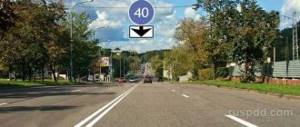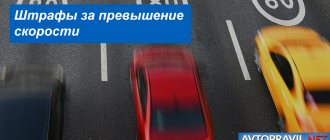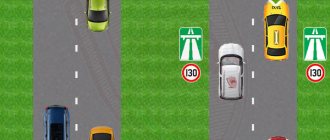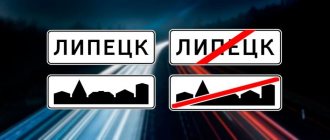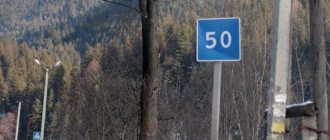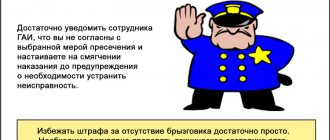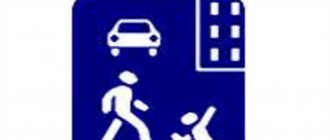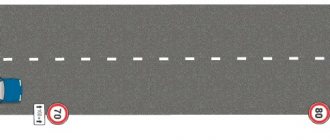Fines for average speed have been abolished - is this true?
In recent months, a myth has been increasingly circulating on the Internet that supposedly punishment for exceeding the average speed has been made illegal, and it is impossible to issue decisions with punishment if the speed recorded is not instantaneous.
It is not true. But the truth is that deputies not so long ago tried to promote a bill that would amend Article 1.5 of the Administrative Code, clarifying that evidence of a violation of traffic rules by a driver is not the calculation of his speed, but only the recording of such a violation in a specific place and at a specific time .
But this project has not yet been accepted, although progress is being made on it.
At the same time, not so long ago the Supreme Court ruled that drivers cannot be fined for their average speed. But this does not make such punishments unlawful and does not even change judicial practice at the level of district and regional courts. But we will definitely find out a working way to challenge such a fine.
The Ministry of Internal Affairs provided clarification regarding fines for exceeding the average speed
Moscow-Live.ru / Akishin Vyacheslav
Moscow-Live.ru / Akishin Vyacheslav
Moscow-Live.ru / Akishin Vyacheslav
The Ministry of Internal Affairs reported that if the same traffic camera recorded an excess of average speed and instantaneous speed, then only one fine can be issued to the speed limit violator. This is stated in the department’s response to an appeal from Grigory Shukhman, an expert in the field of protecting the rights of motorists.
According to Kommersant, Shukhman contacted the departments in connection with the appearance in the media of cases where drivers received several fines for one violation. For example, in July, a driver received two orders after driving on the M11 highway. One fine was issued for exceeding the speed at a specific point in time under the camera, and the second for exceeding the average speed in the area between the two complexes (later the Ministry of Transport of the Moscow Region admitted a software failure). In the Khabarovsk Territory, a car owner received three fines from one camera at once: two for exceeding the instantaneous speed (the system for some reason decided that in this place the limits of 40 and 60 kilometers per hour were simultaneously in effect) and one for the average.
“In the case of simultaneous recording of an offense by an automatic recording device based on the principle of measuring instantaneous speed, which is part of a measuring device based on determining the speed of a vehicle over an extended area, we consider it possible to bring to justice the use of only one of the principles of measuring speed,” - says the response from the Ministry of Internal Affairs.
Let us remind you that fines for exceeding the average speed have been issued since 2013. Traffic cameras can issue fines for drivers exceeding the speed limit when passing a certain section of the road, based on the time spent on its passage - such a system is used in the Moscow region, Tatarstan, Smolensk region and other regions. At the end of last year, the State Duma approved in the first reading a bill providing for the abolition of fines for exceeding the average speed. The reason for the development of the project was the decisions of the courts to cancel such fines due to the absence of the concept of “average speed” in the Code of Administrative Offenses (CAO).
Drivers often appeal fines for exceeding the average speed. Thus, in November last year, the Supreme Court canceled the fine for the average speed calculated between two cameras at a site in the Smolensk region.
First Deputy Chairman of the State Duma Committee on State Construction Vyacheslav Lysakov called the position of the Ministry of Internal Affairs on the inadmissibility of double fines “absolutely obvious.” “Average speed remains illegal, since traffic rules and the Code of Administrative Offenses provide for violation of the speed limit with specific criteria, and the concept of “average speed” is simply absent in both cases. The incidents that happened to car owners are examples of the arrogance and cynicism of local authorities. People see perfectly well that the authorities are not concerned about security, but about profit,” Lysakov said.
The Oko association, which unites manufacturers of traffic cameras and operators of violation monitoring systems, recalled that earlier the association, together with the All-Russian Popular Front, prepared and sent to the Ministry of Justice proposals to include in the draft of the new Code of Administrative Offenses the concepts of “average speed” and “speed over a long section” ", as well as fines for exceeding these speeds.
How do cameras work?
As of May 20, 2021, there are 2 auto-fixing tools that measure average speed:
- Avtodoriya complex,
- Boomerang is not a separate camera, but a means of calculating the average speed for a fine in Cordon systems.
This is what they look like:
In this case, the calculation is quite simple:
- the exact distance between two means of automatic violation detection is known,
- when you pass the first camera, it records the exact time,
- when passing the second camera, the time is also set,
- then, using a simple formula of dividing the distance by the period of time during which it was covered, the average speed is calculated - if it is higher than the permitted speed, then a fine is issued, which is sent to you by mail.
In the diagram, P1 and P2, respectively, are the location points of a pair of cameras, D is the exact distance between them, t is the measured travel time between the points. The average speed, in this case, is calculated as the distance divided by the time it travels.
How it works in practice
Example 1
Imagine that you are driving along a country road and the path lies through a small village. The length of the road section is 1 km, there are cameras at the entrance and exit. Let's say the permitted speed is 60 km/h, if you cover this distance in 1 minute, the speed is normal; faster, you will receive a fine of 500, 1,500, etc. Now imagine that you are driving at a speed of 100 km/h, but If you stop in a village to ask for directions or take a photo, when you leave, no violation will be recorded.
Example 2
Another option: on the road between the cameras there is an accident or a utility accident, a section of the road was blocked, but a short and fast passage was opened, which includes both cameras, you drive at the permitted speed, but faster.
It is legal?
On the one hand, the traffic rules state that the driver has no right to violate the established speed limit. Regardless of whether it is instant or average. But if the calculated average is higher than the permitted limit, then it can be reliably assumed that the driver has exceeded the permissible limit. This is true.
But the legislation does not accept such conventions. It (the 2021 legislation) contains regulations on how, when, in what cases and for what the traffic police can issue fines, how to appeal them and the deadlines for all this.
So, the illegality of fines specifically for average values can be judged by the following postulates of the Code of Administrative Offences.
The Code of Administrative Offenses says nothing about average speed
The violation event itself implies a one-time excess - that is, one fact of moving the car above the permitted speed. Therefore, the violation is considered not to last (it is considered momentary).
When calculating the average speed, it is not possible to reliably determine the fact of excess, as well as their number. Article 12.9 of the Code of Administrative Offenses refers to the fact of speeding, and not to the measurement of the average.
But if you only explain the illegality of the fine with this, then the complaint is unlikely to be satisfied, since this argument rarely convinces the judges.
Changing route
The car could change its route in such a way that the distance between the two cameras decreases. For example, when repairing a road and organizing a detour - such that it turns out to be more direct (instead of driving along the highway to bypass some village or village, drive through this village itself, for example).
Thus, the fine for average speed is essentially illegal and should be cancelled.
Incorrect measurement
The car could be moving at a much higher speed than the average speed recorded by the camera.
For example, you are driving at a speed of 160 km/h when the speed limit is 90. At the same time, you stopped for 5 minutes between a pair of auto-fixation cameras. In this case, the average will be, for example, 120 km/h, which forms the basis for attracting the owner of your car under Part 2 of Article 12.9 of the Code of Administrative Offenses (fine 500 rubles). But in fact, you were moving at a speed that falls under part 4 of this article.
Accordingly, the qualification of the standard of punishment is unlawful, and the fine for exceeding it is illegal.
How legal is this?
The Traffic Rules state that the driver does not have the right to exceed the speed limit set on the road section, in this case it does not matter whether it is instantaneous or average. If the average speed of a section exceeds the permitted speed, then we can talk about an offense.
The legality of this aspect is clear. The whole difficulty in calculating such fines is that the legislation (Code of Administrative Offenses) clearly states the reasons for imposing fines by the traffic police, appeal algorithms and deadlines established for this.
The Code of Administrative Offenses speaks about the illegality of fines for average speed by the following postulates:
The code contains no information at all about average speed. The very event of imposing a fine (offence) implies a single exceeding of the permitted speed by the car. Therefore, violations are considered one-time. In algorithms for calculating average speed, it is impossible to calculate either the moment of speeding or the number of such facts in a selected area. Article 12.9 of the Code of Administrative Offenses speaks about the fact of speeding, but not about the average value and measurement of the average speed. This argument, as a rule, will not be enough for judges, although from the point of view of legal documentation the justification for the illegality of imposing such a fine is quite clear.
- Changing the route. In the section between the cameras, the car could change the route in such a way that the actual distance between the cameras could decrease, for example, when the road is being repaired, the detour could turn out to be more direct than the road itself, or instead of going around the village, the driver could drive through it. In this case, the calculation of the average speed will be incorrect, since one of the key parameters in the formula for calculating speed will change - the distance between two points.
- Incorrect measurement. Do not forget that the speed of the car could be much higher and changed, for example, due to short stops. Different speeds can be the basis for completely different qualifications of the violation and the imposition of different fines. In this case, imposing a smaller fine may also be illegal.
A working way to challenge a fine
Now let’s present the main argument, which, together with judicial practice, will help to successfully appeal fines for average speed.
And this argument is based on a simple logical chain of legislation:
- Article 24.1 of the Code of Administrative Offenses indicates that the case must be considered comprehensively and objectively,
- and norm 26.1 of the Code provides that the offense must be defined by the event itself,
- this event must include the time and place of speeding, since on the basis of this information the place of filing a complaint against a fine is determined,
- at the same time, it is the place and time of the commission of the offense, and not the consideration of the case, that are mandatory data for the possibility of correctly challenging the fine (Decree of the Supreme Court No. 36-AD19-3 of October 17, 2021).
Thus, the time and place where the speeding was committed are mandatory for a full consideration of the case. But for average speed fines, they are not specific. So, if exactly the section of the road from and to is indicated, then it may have jurisdiction over two or more traffic police departments or courts. And this is the main argument when challenging the legality of punishment for average speed.
Judicial practice 2021
It is the Supreme Court Resolution, referred to above, that is essentially fundamental when filing a complaint against a fine for average speed. And it is this decision that should be referred to in the complaint itself, since lower courts are obliged to be guided by the decisions of the Supreme Court.
But this does not mean that they are obliged to make the same decision, so you should not count on the fact that this will lead to a 100% cancellation of the fine. But still, it is this judicial practice that is more convincing for 2021.
We explained in more detail how to challenge a speeding fine in the article about such an appeal. Now you know what arguments need to be given when making a decision based on measuring the average speed. We also recommend reading the article about the general procedure for canceling traffic police fines.
Revocation of license for speeding 2021
If a traffic police officer records a violation of the speed limit, you risk being deprived of your rights in the following situations:
If you exceed the speed limit by more than 60 km/h, but less than 80 km/h, you may lose your license for a period of 4 to 6 months.
For speed exceeding the speed limit of 80 km/h. deprivation of rights may increase for a period of 6 months, and in case of repeated violation, an administrative penalty in the form of deprivation of rights for 1 year will be applied to you.
It is also worth clarifying that this punishment is applied only by court decision. The traffic police inspector can only draw up a protocol and send it to the court, where the final decision will be made. Most car owners are aware of the fact that with a courteous and polite conversation with a traffic police officer, deprivation of your license can be avoided, since you will more than likely only be issued a fine for speeding 2021.

